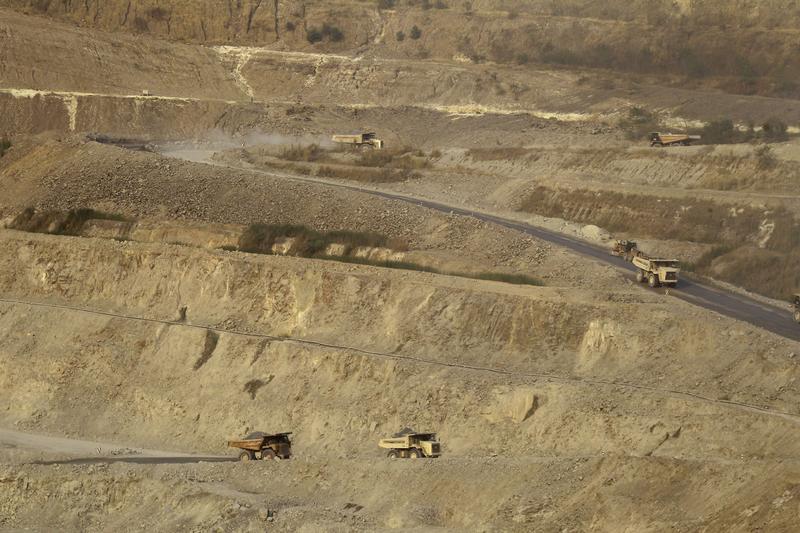The Ministry of Natural Resources and Environmental Conservation said Tuesday that the government has netted almost $20 million in revenue from the Letpadaung copper mining project through the first 10 months of the current fiscal year.
Union Minister for Natural Resources and Environmental Conservation Ohn Win was responding to a question from an MP during a session of the Lower House on profits from the mining venture since the new government took office in April of last year. The Union minister said in total $19,990,876.51 in revenue, including royalties and taxes from the mining project, had been collected in the first 10 months of the fiscal year, which ends on 31 March.
“After the new government took office, 23,166.5 metric tonnes of copper was extracted from the mines between 5 May 2016 and 31 January 2017, netting the country US$19,990,876.51 in revenue,” said Ohn Myint.
The Letpadaung copper mine in Sagaing Division’s Monywa, a joint venture between the Burmese military-owned Union of Myanmar Economic Holdings Limited (UMEHL) and Wanbao Mining Ltd, a subsidiary of the Chinese state-owned China North Industries Corporation (Norinco), began operations after signing a contract in 2010. The developers subsequently faced a series of protests by local villagers who were forced to relocate to make way for the project and were dissatisfied with the resettlement process and compensation scheme, as well as the mine’s environmental and health impacts.
Following a recommendation of the Aung San Suu Kyi-led Letpadaung Copper Mining Project Investigation Commission, the contractual agreement between the stakeholders was amended in 2013. Under the revised agreement, 51 percent of profits go to the Burmese government while UMEHL gets 19 percent and Wanbao is granted 30 percent. Two percent of the overall profit must be allocated for regional development.
Ohn Win’s remarks before Parliament on Tuesday came just days after the release of an Amnesty International report warned that plans to expand the Letpadaung mine will put hundreds of villagers at risk of forced eviction.
Its operators plan to grow the mine’s perimeter by a further 2,000 acres, but villagers say there has been no genuine consultations with the affected population.
In Amnesty International’s report, “Mountain of Trouble: Human Rights Abuses Continue at Myanmar’s Letpadaung Mine,” released last week, the ongoing threat of forced evictions; environmental contamination affecting villagers’ health; and the ongoing harassment of protesters were documented as serious ongoing human rights abuses.
“Myanmar desperately needs big business projects like the Letpadaung mine to succeed. But these should not come at the cost of local communities. The government needs to intervene and suspend operations until all human rights and environmental concerns are properly investigated and addressed,” said Mark Dummett, Amnesty International’s researcher on business and human rights.
While UMHEL and Wanbao would appear to have made millions over the last 10 months, the affected community says they are paying the bill, in the form of lost crops due to serious environmental damage to their lands and at times repression for protesters.
Since the mine opened, villagers have been prosecuted for peacefully protesting and no compensation or person has been held accountable for the use of white phosphorous munitions launched against protesters, nor has there been justice for the late Khin Win, a villager who was shot dead by police while protesting in 2014.
“Instead of holding the officials accountable for the use of white phosphorus and the death a protester, the authorities are punishing the victims. Using crude and repressive laws, they are harassing, monitoring and prosecuting people who are only asking for justice,” said Dummett.
[related]
One case documented by Amnesty involved a farmer whose crops perished after a waste leak in November 2015 ran onto his land. According to the farmer, the mine’s operators have not cleaned up the spill or compensated affected villagers.
In 2016, Amnesty asked environmental expert Alan Tingay to review the environmental and social impact assessments for the Letpadaung operation and he found that the reports didn’t act on previous deficiencies identified, such as the lack of a buffer zone between the mine and neighbouring communities.
The eastern edge of the mine, which sits on the flood plain of the Chindwin River, has also been identified as a risk — in particular, if floodwaters enter dump sites at the mine, contaminated material from the mine could be spread.
Myanmar Wanbao said that it devised a “contribution plan,” in which villagers who lost land would receive compensation in the form of a monthly payment. According to Myanmar Wanbao, the majority of people (83 percent from 35 communities) who lost, or stood to lose, land had accepted this compensation by May 2016, but Amnesty International found the company’s claims to be false, and that “far from reaching all affected people, the consultations excluded many people affected by the land acquisition.”
Amnesty says there is no record in the environmental and social impact assessments of residents of Kandaw, Saedee, Wet Hme and Zeedaw villages, suggesting that these villages were excluded from consultations altogether.
Additional reporting by Libby Hogan.



